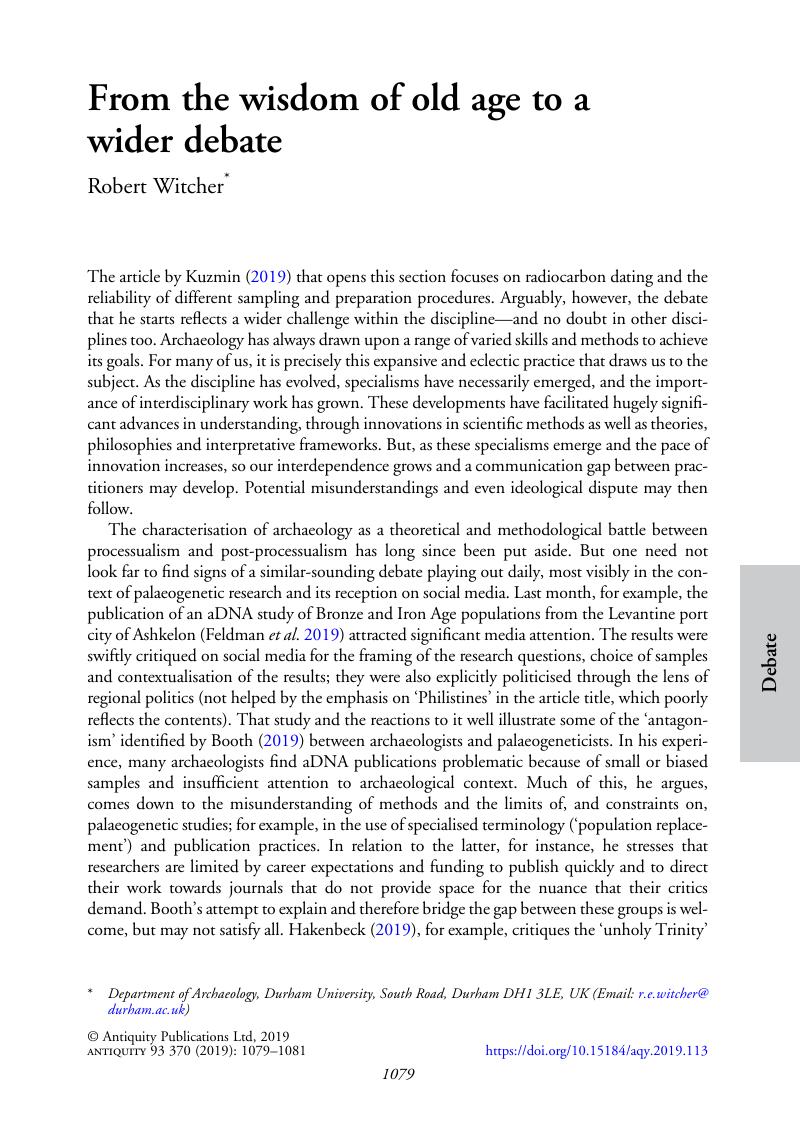No CrossRef data available.
Article contents
From the wisdom of old age to a wider debate
Published online by Cambridge University Press: 12 August 2019
Abstract
An abstract is not available for this content so a preview has been provided. Please use the Get access link above for information on how to access this content.

- Type
- Debate
- Information
- Copyright
- Copyright © Antiquity Publications Ltd, 2019
References
Booth, T.J. 2019. A stranger in a strange land: a perspective on archaeological responses to the palaeogenetic revolution from an archaeologist working amongst palaeogeneticists. World Archaeology. https://doi.org/10.1080/00438243.2019.1627240Google Scholar
Brophy, K. 2018. The Brexit hypothesis and prehistory. Antiquity 92: 1650–58. https://doi.org/10.15184/aqy.2018.160.Google Scholar
Feldman, M., Master, D.M., Bianco, R.A., Burri, M., Stockhammer, P.W., Mittnik, A., Aja, A.J., Jeong, C. & Krause, J.. 2019. Ancient DNA sheds light on the genetic origins of Early Iron Age Philistines. Science Advances 3 July 2019: EAAX0061.Google Scholar
Hakenbeck, S.E. 2019. Genetics, archaeology and the far right: an unholy trinity. World Archaeology https://doi.org/10.1080/00438243.2019.1617189Google Scholar
Harvati, K. et al. 2019. Apidima Cave fossils provide earliest evidence of Homo sapiens in Eurasia. Nature. https://doi.org/10.1038/s41586-019-1376-zGoogle Scholar
Higham, T.F.G. 2019. Removing contaminants: a restatement of the value of isolating single compounds for AMS dating. Antiquity 93: 1072–75. https://doi.org/10.15184/aqy.2019.89Google Scholar
Holen, S.R. et al. 2017. A 130 000-year-old archaeological site in southern California. Nature 554: 479–83. https://doi.org/10.1038/nature22065.Google Scholar
Kuzmin, Y.V. 2019. The older, the better? On the radiocarbon dating of Upper Palaeolithic burials in Northern Eurasia and beyond. Antiquity 93: 1061–71. https://doi.org/10.15184/aqy.2018.158Google Scholar
Magnani, M. et al. 2019. Evaluating claims for an early peopling of the Americas: experimental design and the Cerutti Mastodon site. Antiquity 93: 789–95. https://doi.org/10.15184/aqy.2019.14Google Scholar
McNabb, J. 2019. Evaluating claims for an early peopling of the Americas: the broader context. Antiquity 93: 802–807. https://doi.org/10.15184/aqy.2019.52Google Scholar
Pettitt, P. 2019. Fast and slow science and the Palaeolithic dating game. Antiquity 93: 1076–78. https://doi.org/10.15184/aqy.2019.110Google Scholar
Wade, L. 2019. Skull fragment from Greek cave suggests modern humans were in Europe more than 200,000 years ago. Science 365 (10 July 2019). https://doi.org/10.1126/science.aay6927Google Scholar




